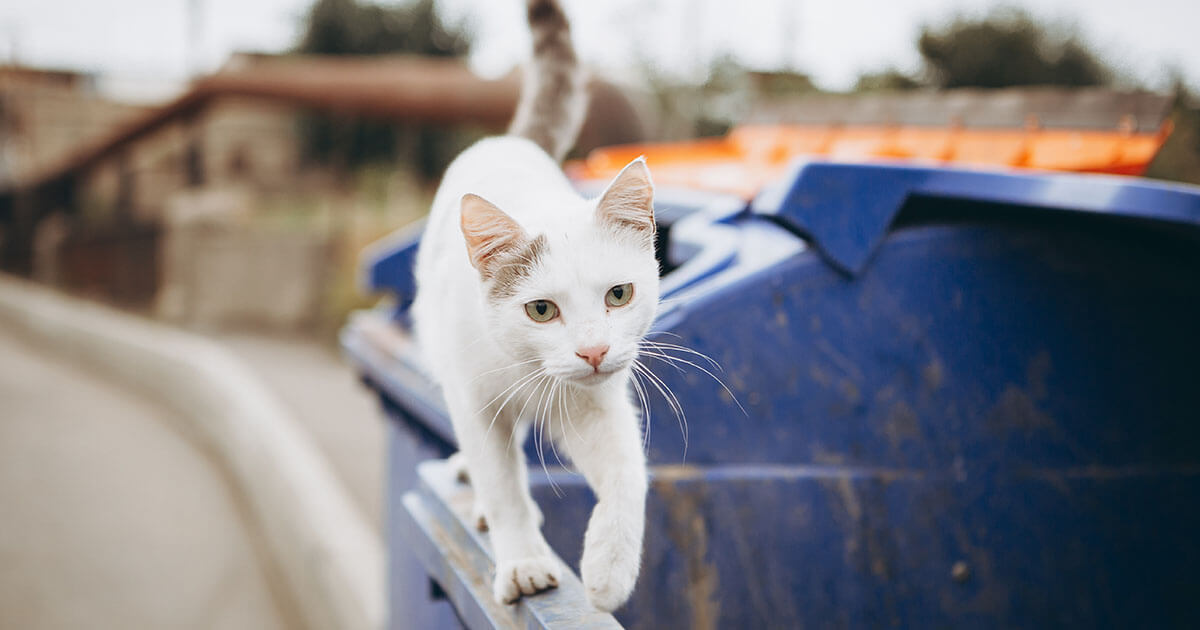Stray cats can potentially be dangerous due to disease and unpredictable behavior. They may carry rabies, parasites, or cause injuries through bites and scratches.
Stray cats, often known as feral cats, roam neighborhoods and urban environments, stirring mixed feelings among residents. While some view them as harmless and even beneficial for controlling the rodent population, others see them as a nuisance and health risk.
Encounters with stray cats should be approached with caution; they are not accustomed to human interaction like domesticated pets. Being independent survivors, they can be territorial and may aggressively defend themselves if they feel threatened. An understanding of the risks and safe ways to interact can foster coexistence with these feline wanderers in our communities. It’s essential to maintain a respectful distance and consult animal control services if a stray cat poses a consistent problem or threat.
Myth Vs. Reality: Stray Cat Perceptions
Stray cats often stir up mixed feelings in neighborhoods. Some view them as pests, while others see them as harmless creatures. What’s the truth? Let’s debunk myths and unveil the realities surrounding these feline wanderers.
Common Beliefs About Stray Cats
- Stray cats are aggressive and dangerous.
- They carry diseases harmful to humans.
- All stray cats are wild and cannot be domesticated.
These beliefs drive people to fear or avoid stray cats. But are these fears based on facts or misconceptions? We dive into each belief to separate myth from reality.
The Truth Behind Stray Behavior
Understanding stray cat behavior is key to learning how dangerous they really are. Let’s address each common belief:
| Belief | Reality |
|---|---|
| Aggressive and dangerous | Most strays avoid humans due to fear, not aggression. |
| Disease carriers | While strays can carry diseases, so can pets. Vaccinations and care reduce risks. |
| Cannot be domesticated | Many strays are lost or abandoned pets and can adapt to a home with patience and love. |
Stray cats often need understanding, not fear. Let’s create a friendly environment for these misunderstood creatures.
Health Risks Associated With Stray Cats
Stray cats may seem harmless at a glance. Close encounters with them can pose health risks. These felines can carry diseases harmful to humans. Let’s explore the possible risks and stay informed on how to coexist safely with these independent creatures.
Potential Diseases From Stray Cats
Stray cats can carry various diseases that can transfer to humans. These include:
- Toxoplasmosis, which can cause flu-like symptoms.
- Feline leukemia (FeLV) affects cats only but shows the importance of disease in strays.
- Feline Immunodeficiency Virus (FIV) also affects cats but indicates their health status.
- Parasites like fleas, ticks, and worms that can spread to humans.
Understanding Zoonotic Threats
What are zoonotic threats? They are diseases that can jump from animals to humans. Stray cats, as carriers, increase this risk. It’s important to recognize these threats for human and animal safety.
Rabies And Stray Cats: A Real Concern?
Rabies is a deadly virus that affects the brain and spinal cord. It can spread through bites or scratches. Stray cats without vaccination may carry rabies. Always approach stray felines with caution.
| Disease | Transmission | Symptoms in Humans |
|---|---|---|
| Toxoplasmosis | Handling cat litter or soil | Flu-like symptoms, muscle aches |
| Bacterial Infections (e.g., Cat Scratch Disease) | Bites or scratches | Fever, swollen lymph nodes |
| Rabies | Bites or scratches | Fever, headache, excess salivation |
Understanding these risks helps in creating a safe environment. Always maintain distance from stray cats. If necessary, contact animal control for assistance. Keeping our community safe is a shared responsibility.
Stray Cats And Aggression
Stray cats often evoke mixed feelings. Some see them as lonely creatures in need of care, while others worry about potential aggression. Understanding a stray cat’s behavior is crucial to safely interacting with them.
Factors Contributing To Feline Aggression
Several factors can cause a stray cat to act aggressively. These factors range from their health to the environment. Let’s delve into some key contributors:
- Health Issues: Pain or illness can make any cat lash out.
- Protection: A cat may become aggressive to guard food or kittens.
- Fear: Stray cats often face dangers, making them skittish or defensive.
- Mistreatment: Past abuse can cause mistrust and aggression.
Recognizing these signs is the first step towards safe interaction.
Myth: All Stray Cats Are Aggressive
It’s a common misconception that all stray cats possess an aggressive nature. Like all animals, stray cats have unique personalities and behaviors. Simplifying their behavior under one label is misleading. Here’s why not all stray cats are aggressive:
- Many are abandoned pets, used to human company.
- Socialization levels vary among strays; not all are feral.
- Stray cats can exhibit affection if they feel safe.
Understanding the nuances in stray cat behavior helps in promoting a positive coexistence.
Credit: www.abc.net.au
The Impact Of Human Interaction
The Impact of Human Interaction on stray cats is complex. It shapes their health, behavior, and population dynamics. Understanding this impact guides how we can responsibly coexist with these independent felines.
How Feeding Affects Stray Cats
Regular feeding by humans can lead to various outcomes for stray cats:
- Improved health and survival rates due to better nutrition
- Increased population growth, as well-fed cats are more likely to reproduce
- Possible dependence on human-provided food sources
These points underline the need for responsible feeding practices. These practices should aim to maintain the cats’ independence while supporting their well-being.
The Role Of Socialization In Stray Cat Behavior
Human interaction plays a critical role in socializing stray cats:
- Socialized cats are often friendlier towards humans.
- They may be easier to adopt into a home environment.
- Lack of socialization can lead to fearful or aggressive behaviors.
Building trust through gentle interaction over time can positively affect a stray’s disposition. Socialization can pave the way for safer and more harmonious relationships between humans and stray cats.
Managing Stray Cat Populations Safely
Managing Stray Cat Populations Safely deals with finding humane and effective methods to control the number of homeless felines. Stray cats, while generally not aggressive, can pose health risks and disrupt local wildlife ecosystems. Addressing their populations is vital to ensure the safety of both the cats and communities. Implementing organized strategies keeps neighborhoods and cats healthy.
Trap-neuter-release Programs
Trap-Neuter-Release (TNR) initiatives work wonders in managing stray cats. Captured cats receive spaying or neutering surgery. They get vaccinated against diseases, too. Once these cats recover, volunteers return them to their territory. This method prevents overpopulation while allowing cats to live out their lives.
- Efficient for controlling populations
- Reduces potential for disease spread
- Ensures humane treatment
Community Efforts In Stray Cat Management
Local communities play a pivotal role in stray cat management. Informing residents about stray cat behaviors and risks encourages responsible action. Communities can organize feeding schedules to keep cats healthy and prevent nuisance behaviors.
| Action | Impact |
|---|---|
| Public Education | Less Fear, Better Care |
| Scheduled Feeding | Controlled Food Resources |
| Shelter Provision | Safe Havens for Cats |
Shared responsibility ensures an effective response to the stray cat challenge. Residents can collaborate with local authorities or animal welfare groups.

Credit: www.theguardian.com
Protecting Yourself And Stray Cats
Stray cats often wander our neighborhoods and parks. Understanding how to protect both you and these independent felines is essential. Not all stray cats are dangerous, but it’s crucial to approach them with caution and respect. This post is all about ensuring a safe interaction between humans and stray cats. We’ll cover vital safety precautions and know when to call animal services.
Safety Precautions When Approaching Strays
- Observe from a distance: Watch the cat’s behavior before getting too close.
- Avoid sudden movements: Keep calm to not scare the animal.
- Do not touch: Strays might carry diseases; avoid touching without proper safety measures.
- Wear gloves: If contact is necessary, protect your hands.
- Offer food carefully: Place food down and step back to allow the cat to approach.
When To Contact Animal Services
| Action | Reason |
|---|---|
| Immediate Contact | Cat is injured or appears sick. |
| Non-Urgent Contact | Cat is well but has no identification. |
| Shelter Inquiry | If the cat is causing issues or seems lost. |
Remember, stray cats need our compassion. Yet your safety comes first. Take these steps to ensure positive outcomes for both you and the strays you may encounter.

Credit: www.amazon.com
Frequently Asked Questions Of Is Stray Cat Dangerous
Is It Safe To Touch A Stray Cat?
Touching a stray cat can be risky due to potential disease or aggressive behavior. Always assess the cat’s demeanor and use caution. It’s best to avoid touching unless you’re helping the animal. Remember to wash hands thoroughly after any contact.
Is It Ok To Take In A Stray Cat?
Taking in a stray cat is acceptable, but ensure your safety first by consulting a veterinarian. Check for a microchip to possibly return it to its owner. Gradually introduce the cat to your home, and provide proper care and attention.
Always consider local regulations regarding stray animals.
What Problems Do Stray Cats Cause?
Stray cats can spread diseases, trigger allergies, cause noise pollution, and harm local wildlife. They often compete with native animals for food and territory, leading to ecological imbalances.
How Do You Know If A Stray Cat Is Safe?
To determine if a stray cat is safe, observe its behavior and health. Look for friendly gestures, such as rubbing against legs, and check for clear eyes, a clean coat, and normal mobility. Avoid cats showing aggression or signs of illness.
Always approach with caution.
Conclusion
Navigating the world of stray cats requires balance. Understanding their behavior is key to managing any potential risks. They often pose no threat, yet caution is needed in handling unknown animals. Remember to respect their space and consider consulting professionals for safe interactions.
Ultimately, stray cats deserve our compassion and care.

